Niche Blogging Hub.
If you are an entrepreneur looking for all the resources you need for niche blogging on a single page, this page has exactly what you need.
Learn what niche blogging is, how to create a niche blog that makes money, micro-niche blogging tips, best blogging niche ideas, and more.
Overview
Niche blogging is probably one of the biggest trends recently. The reason is that it can dramatically increase your chances to succeed in an extremely competitive online world.
Creating a niche blog can help you drive more targeted customers to your website while removing some competence. It can make the difference between a profitable website and a website buried by competitors.
On this page, you’ll learn all you need to do to create a niche blog- from blog niche ideas to a step-by-step guide to creating your own site. It offers a comprehensive guide and a library of resources to help you understand what niche blogging is and how to create a profitable niche blog.
*Disclosure: I only recommend products I would use myself, and all opinions expressed here are my own. This page may contain affiliate links that at no additional cost to you, I may earn a small commission.
- Niche Blogging Hub.
- What is niche blogging?
- How To Start Niche Blogging.
- How to make money with a niche blog.
- Promoting your niche blog.
- Micro niche Blogging.
- best niches for blogging.
- Did you enjoy this article?
What is niche blogging?
First, let’s start by explaining what is niche blogging.
Niche blogging is the act of creating a blog with the intent of using it to market to a particular niche market.
Niche blogs (also called “niche websites“) may appeal to people in specific locations, with particular interests, and from certain ages. And this is exactly what makes them so powerful.
If you create a product or service and present it to a very targeted audience, chances are your conversion rate and income will be higher than generic websites. Since you will be tackling a problem for a very defined audience (target audience), they will see in you the resources they need.
In summary, when your blog focuses on a particular topic for a very targeted audience, it is called niche blogging.
Why you should start a niche blog.
If you think about it, you probably spend more time visiting blogs or websites about specific topics you like rather than generic sites.
Niche blogs usually cover topics more in-depth, which keeps readers happy. If a reader finds a blog topic interesting on a niche website, there will likely be much more content they will want to read since they fit the same category.
This will translate into more traffic from people with a real interest in what you have to say. This audience is easier to convert to subscribers, and either if you sell goods or are an affiliate marketer, you will build just a perfect list of potential customers.
Some of the benefits of starting a niche blog are:
- Niche blogs are content-rich. Generic blogs rarely cover topics as in-depth as niche blogs do. This not only makes people happier but also Google, which helps you rank higher. This means more happy readers all the time.
- Niche blogs help you rank faster. Focusing on a specific topic will help you build authority as an expert on that topic. Search engines reward this and push your rankings higher as an authoritative figure.
- Niche blogs are easier to maintain. You can easily stay on top of new trends and always write blog posts relevant to your audience. It is also easier to find related topics when creating your content calendar.
- Niche blogs make it easier to build a reliable audience. Your niche audience will come to visit your blog more often. Many of them will likely become subscribers and customers.
- But overall, niche blogs are easier to monetize. If you put each of the niche blogging benefits above, they all point to the same- They will help you make money with your website faster than a generic site could do.
How to find your blogging niche.
In order to find your perfect blog niche, you will need to take a series of steps:
- Brainstorm niche market ideas. You can use SEO tools for this, social networks, and even forums. Try to look for a “popular issue” within your community, and your product or service could be the solution to that problem.
- Validate your idea with niche trends. Once you have a list of potential niches, you can easily validate your idea with Google Trends. All you need to do is to type your idea and inspect the trend. You want to choose a niche with a stable trend or a growing trend.
- Study your niche competitors. You can get a lot of useful information from your competitors- you can learn if they are big brands, what kind of content they create to attract visitors, how they monetize, and more. This can be very useful to find out if your niche idea can be profitable and also to find some more niche ideas.
- Perform niche keyword research. Lastly, you will need to create a list with your potential keywords for your content strategy. So, I recommend you use an SEO tool to make this. You will need a list of keywords with low competition, so take your time until you have the perfect list of keywords for your blog.
Lastly, I suggest you check how to do niche research step by step in this ultimate guide.
Blog Niche Ideas.
Now you know a bit more about niche blogging, here are some blog niche ideas that you could use:
- Health and Wellness
- Skincare
- Tourism
- Art
- Fitness
- Photography
- Sports
- Pets
- Food
- Travel
- Gaming
- Relationships
- Technology
- Finance
- Self-improvement
- Lifestyle
- Blogging
- Education
- Photography
- Fashion
For more niche-specific blog ideas, I suggest you check these articles:
- 336 Best Blog Niche Ideas for a Successful Business
- The 10 Best Ecommerce Niches
- The 10+ Best Drop Servicing Niches
- The 10 Best Dropshipping Niches
- 10+ Best Instagram Niches to Make Money
- The 20 Best Affiliate Marketing Niches (+How to Monetize Them)
Blog Niche examples.
Blog niche example 1: Affilorama
Let’s start with a digital marketing example. There are thousands of sub-niches within digital marketing. So unless you narrow down enough to a specific niche market, you will find it very hard to succeed, especially in affiliate marketing, one of the most competitive niches out there.
Affilorama knows that. And they also know that more and more entrepreneurs are venturing into the affiliate marketing world. That is why they have created a website full of resources for entrepreneurs to learn how to make money with affiliate marketing.
Meaning they have niched down from digital marketing > affiliate marketing > affiliate marketing training > affiliate marketing training for beginners. That is a clever way to stand out.
Blog niche example 2: Nomads RTW.
This is another excellent example of a niche blog within the travel niche.
There are thousands of travel sites. So, engaging fellow travelers these days is much more complicated. But Nomads RTW is not the usual travel blog. It is a travel blog focused on sustainable experiences.
They provide responsible travel tips and experiences with very curated photography. Not everyone might like that, of course. But if you want to travel sustainably and love photography, this can be a great match.
How To Start Niche Blogging.
In order to create your niche website, you’ll need to:
- Find a niche.
- Pick your domain and hosting.
- Install WordPress.
- Install a theme.
- Make your logo.
- Plan your content strategy.
- Write amazing blog posts.
Let’s cover each of them in detail.
1. Find a niche.
The first step to creating your niche blog is to find a niche.
When looking for a niche, you should try to find something you are passionate about that can make money.
Try not to be influenced by the articles you read about “how I made $3,000 my first month in the health niche”. This might be true, but I can guarantee it is not common. It normally takes some time until things work out. And ultimately, it will depend on your strategy and niche.
I suggest you start by thinking about these questions.
- Are you willing to spend hours researching and maintaining this niche for years?
- Are people spending money already in this niche?
- Can I cover this niche in depth? This means covering every angle of this niche and writing thorough and extensive articles.
- Can I outrank the competition in this niche? Your niche might be profitable, but it will be hard for you to succeed if there is a lot of competition already.
- Can I find enough competitive keywords? One of the main issues these days is the amount of information out there. Finding keywords with low competition can be tough. But with a good keyword research service, which you will need, and focusing on new trends and products, you can find your way.
If you answered yes to every question, you are already one step closer.
Also, I suggest you check the full guide on niche research.
2. Pick your domain and hosting.
Once you have decided on your niche, you’ll need a domain and hosting. This is where your website would be hosted to make it accessible to the world.
There was a time when the domain name was key for SEO purposes, but this is no longer the case.
The only important thing when it comes to choosing a domain is:
- Make it short and memorable.
- Go always for the .com
- Avoid hyphens.
- Use broad terms so you can scale your business. i.e., if you call it bluelaces.com and want to sell red laces in the future, it wouldn’t look good.
As per the hosting, my preferences are:
- Bluehost. Affordable and beginner-friendly. This is normally the preferred option for new bloggers with a limited budget.
- Siteground. This is my preferred option due to its speed optimization with 5 servers distributed worldwide. It works incredibly well and offers outstanding customer service. This is the one I use for this site.
- Kinsta. This is simply the king of speed. It is a premium managed WordPress hosting that features a modern interface that is very easy to use, but it comes at an elevated price. However, if you have the budget, you’ll be happy with this.
You might want to read some of my reviews to help you decide:
- Kinsta Hosting Review: Pros, Cons, Pricing, and Alternatives.
- Kinsta vs Siteground: The Best WordPress Hostings Compared
You can find how to sign up and how to use them in the articles mentioned previously.
Lastly, regardless of the hosting you choose, you can easily check domains and purchase them directly through your hosting provider.
3. Install WordPress.
The good news is that installing WordPress is easier than ever. Most of the hosting providers already include a one-click installation, so you can install WordPress within seconds and without any knowledge.
Here is how to easily install WordPress with each of the options mentioned before:
And as simple as that, we can proceed to the next step now.
4. Install a theme.
A theme is a collection of templates and stylesheets used to define a WordPress-powered website’s appearance and display. They can be changed, managed, and added from the WordPress admin area under Appearance » Themes.
There are several free and paid WordPress themes available. So which one should you choose? If you are testing and don’t want to invest much time or money in this project, I suggest you go for a free Theme. However, if this will be your business, you should treat it as such and go for a premium theme. You don’t need to waste a lot of time (like I did) to understand that a free theme will hardly have the features a premium theme has.
As a rule of thumb, you can expect a higher quality throughout from premium themes compared with their free counterparts. They are normally feature-rich, responsive, and well-supported by the vendor’s support staff. Having said so, the decision is ultimately your choice. I will provide you with my recommendations for free and premium themes.
- Recommend Free WordPress Themes: Themeisle
- Recommended Paid WordPress Themes: Elegant Themes.
Once you have decided on a theme, you’ll need to download and install it first. All the themes come with an easy installation guide, but in any case, this is how you can install any theme in WordPress:
Step #1. Login to your WordPress
Step #2. You’ll see a panel on the left-hand side of the main screen. Navigate to Apperance>Themes.
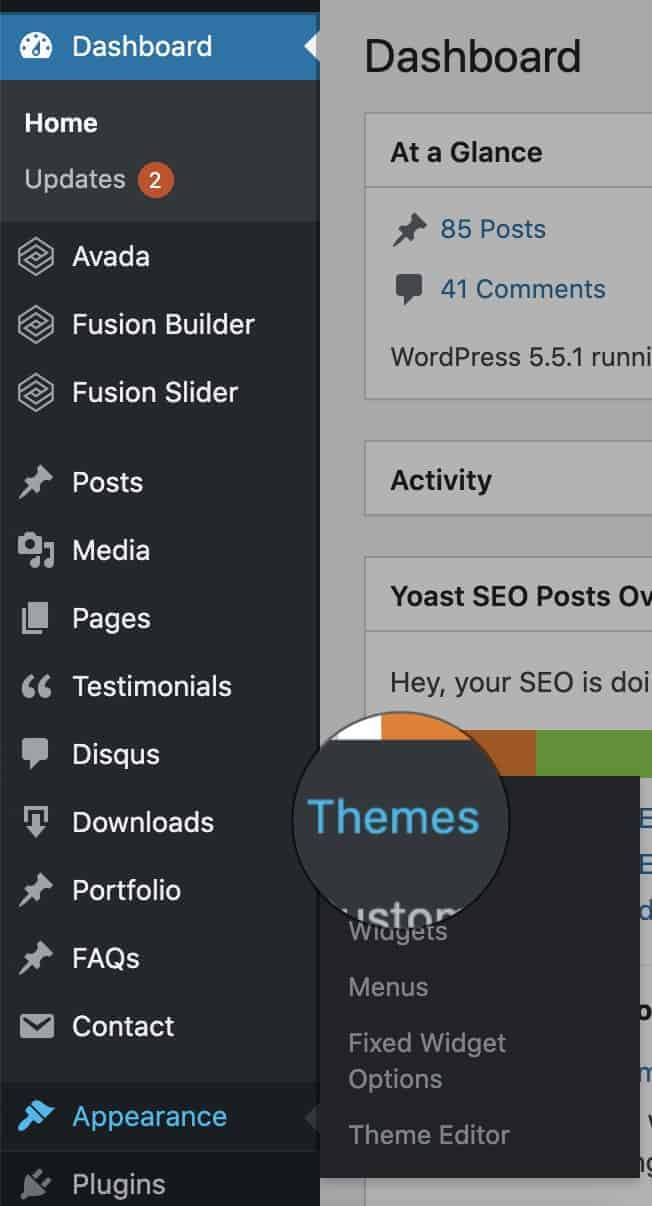
Step #3. Click on “Add new.”
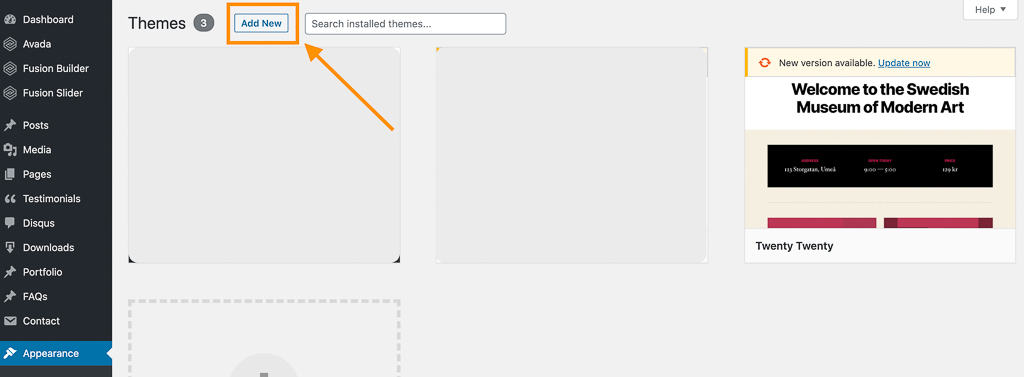
Step #4. Click on “upload theme.”
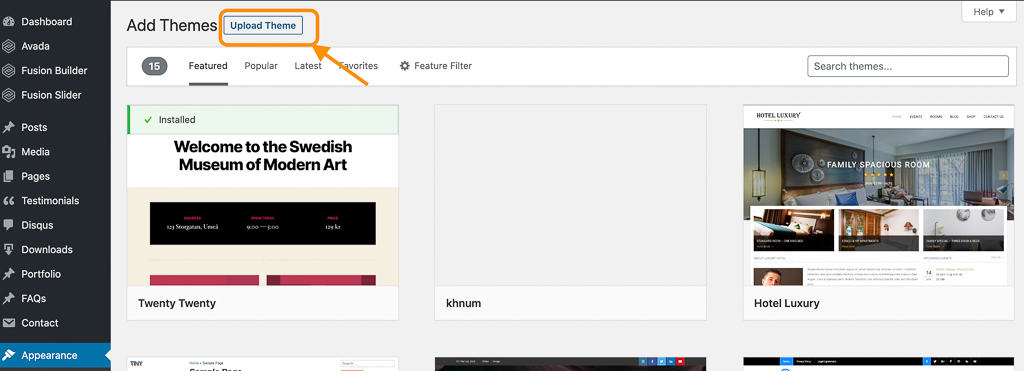
Step #5. Now, all you need to do is to click on “choose file” first, select the theme you have previously downloaded, and secondly, click on “Install Now.”

And that’s it. Now, you have your theme installed on your WordPress account.
5. Make Your Logo.
Your logo is going to be your business identity. So you should put some weight on it.
You should make a logo aligned with the vision and voice of your website. When someone lands on your website, the logo is one of the first things they will notice. And first impressions do count online. Remember, this project is going to be your business. So, a bit of dedication and investment is a must.
If you are good with design, you can try making it yourself free using Canva. However, if you want a professional touch and get something special for your website, you should try Fiverr. Fiverr is a platform where you can hire a freelancer to do pretty much any online job. And what is great about this platform is that you can find a professional to make you a logo for 20 bucks or less and in one day.
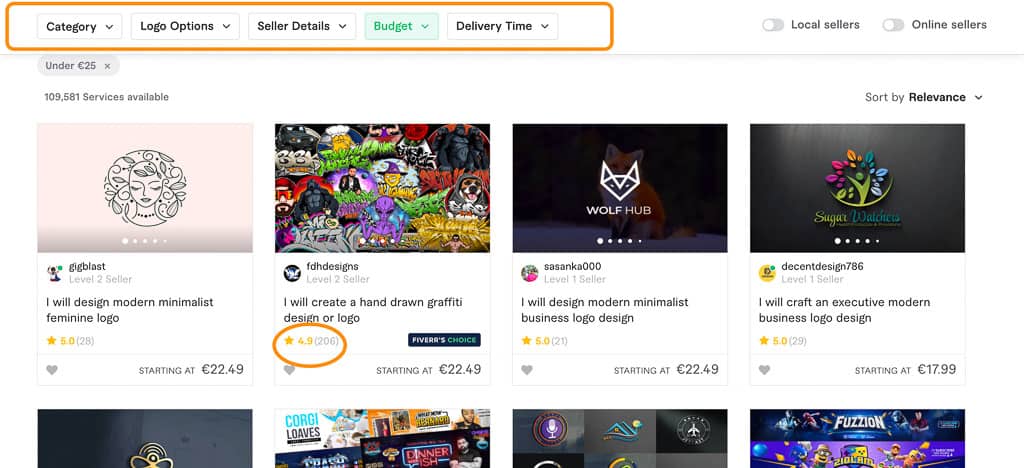
The important thing is to make sure your logo represents your website.
Once you have your shiny logo, head to your website and try it. You can upload a logo to your WordPress dashboard by clicking on Appearance>Customize.
6. plan your content strategy.
How do I prepare my content strategy? You might ask. Doing a thorough niche keyword research.
The ultimate objective is to make money with your website and to do that, you need to drive traffic to your site. But there is a strategy you need to follow. You should not write just for the sake of it.
You need to brainstorm topics your audience would be interested in. These topics need to solve an issue for this audience. But you also need to ensure there is no fierce competition around it. Otherwise, it would be of no use to have an amazing article of 5000 words when no one will find it, translating into no traffic and ultimately no money.
The best way (and more reliable) to get traffic is through SEO (search engine optimization). SEO is an acquisition channel that will grow passively. As long as you are ranking well for the keywords you’re targeting, you will get passive traffic. So, you should focus on creating content for topics with search traffic potential.
SEO through Keyword Research.
There are many places where you can start looking for topics that might interest your audience. Some of the best places where to find valuable information are:
- Facebook groups. Look for specific groups about your niche and find out what people are talking about. Not only can you find great topics this way, but you can come later to the same group and post your article to start driving traffic to your site.
- AnswerThePublic. This is a great site to find questions people ask about a topic. You need to type your keywords, and it will populate a bunch of useful questions you can use.
- Udemy. This is one of the most used platforms for online teaching. So here you can find a great variety of topics people are very interested in.
- Communities like Quora, Reddit, and forums. People used to gather in these places, and they could be a mine of gold. Browse through popular topics, and you might find something interesting.
Even though those are handy resources for topic research, you will still need to know the search volume and how difficult it is to rank for the keywords you find. So, you are going to need an SEO tool.
My top SEO tool preferences are:
- Keysearch. This is one of the best value for money when it comes to SEO. It is powerful enough and offers all you might need to start. This is great for beginners.
- SE Ranking. This is a great all-in-one SEO tool, straightforward to use, and for all public. It offers a free 14-day trial, so I suggest you give it a try.
- SEMrush. If you are serious about SEO and want to have access to the most powerful and complete SEO tool, this is the one.
Finding keywords for your content.
For this example, I will use SE Ranking. To find a list of keyword ideas with keyword research, you just need to:
Step #1. In SE Ranking, head to the “Keyword Research” module.

Step #2. Type your keyword idea and click “analyze“.

Step #3. Scroll down to the “keyword ideas” section. Although both similar and related keywords will help, there are more results on “similar keywords.” So click on “View detailed report” under similar keywords.
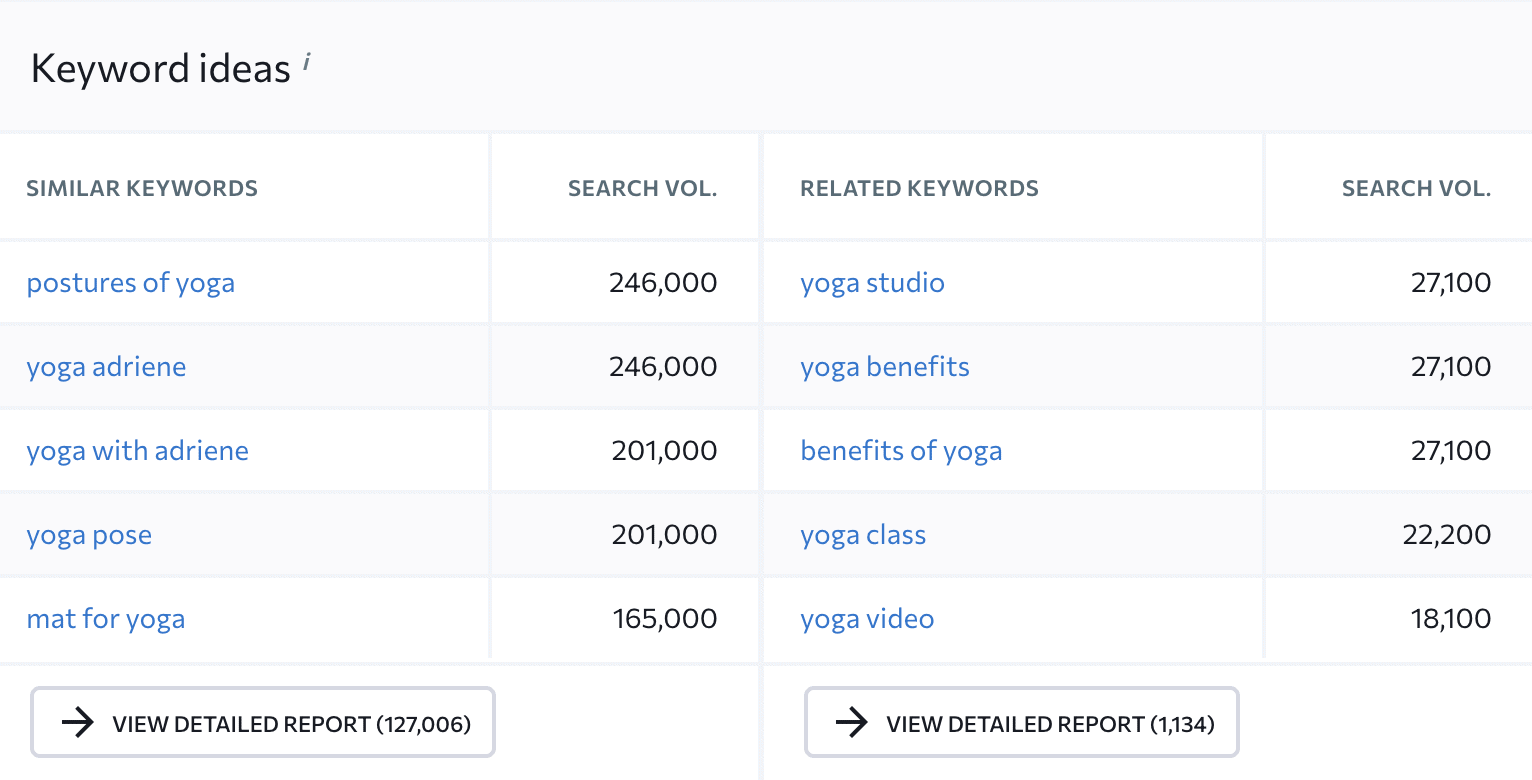
Step #4. Next, you will find a massive list with similar keywords, where you can also choose from related and low search volume keywords. Additionally, you can filter out your results to find exactly what you want.
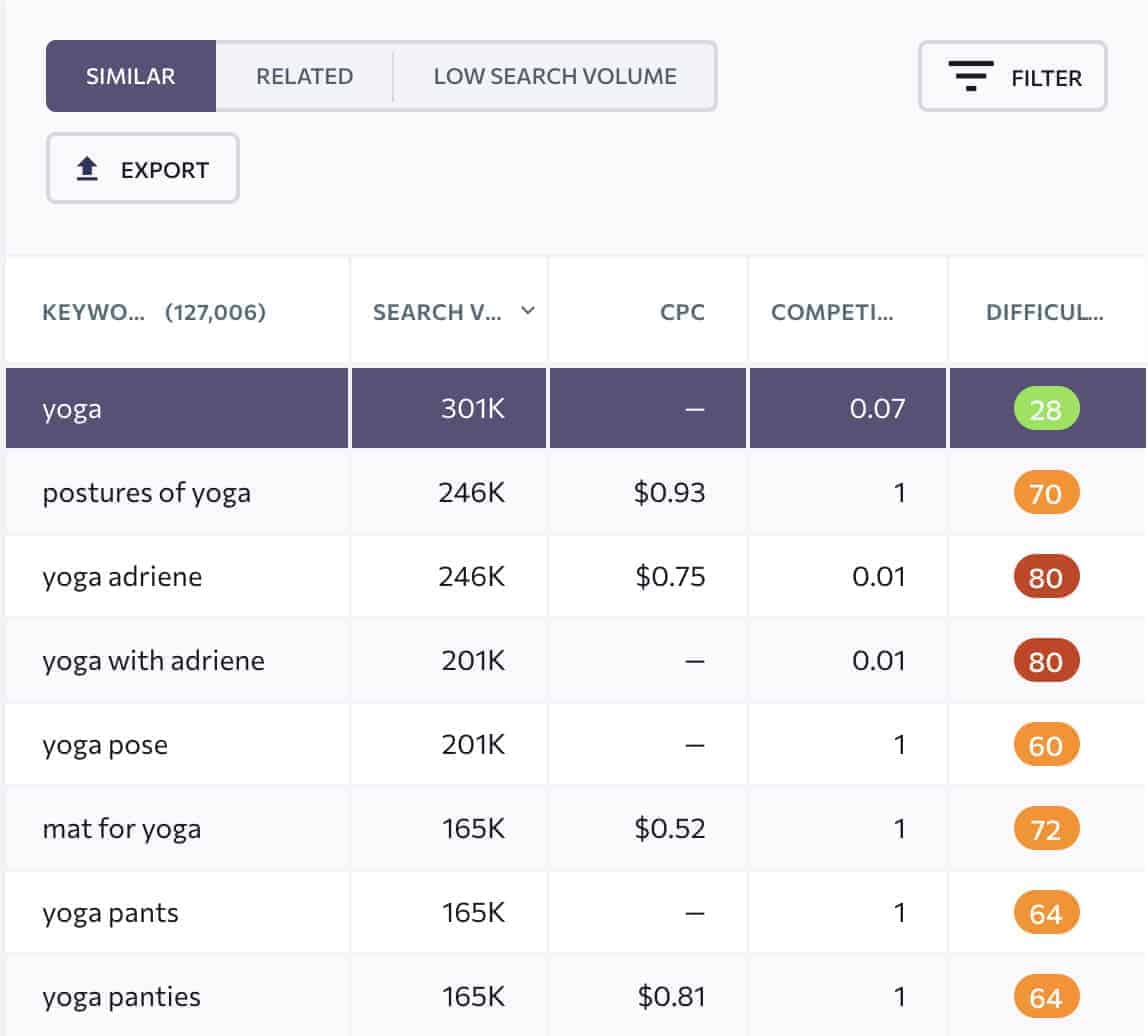
Step #5. Click on the “Filter” button and set your desired values. I will set it for a minimum volume of 200, CPC at least 1, and difficulty score under 40. Then click on “Apply filters.”
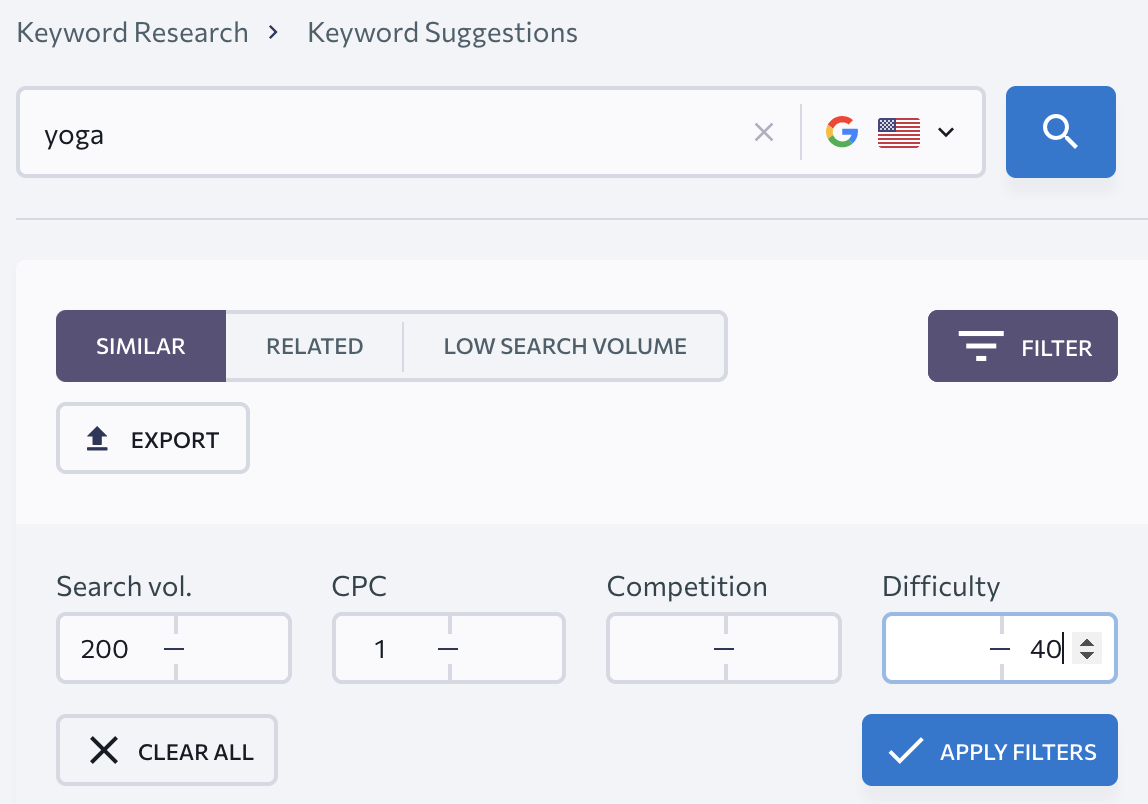
Step #6. You will get a refined list of keywords according to the values set. You can even order the list by values by clicking on the column you want to sort.
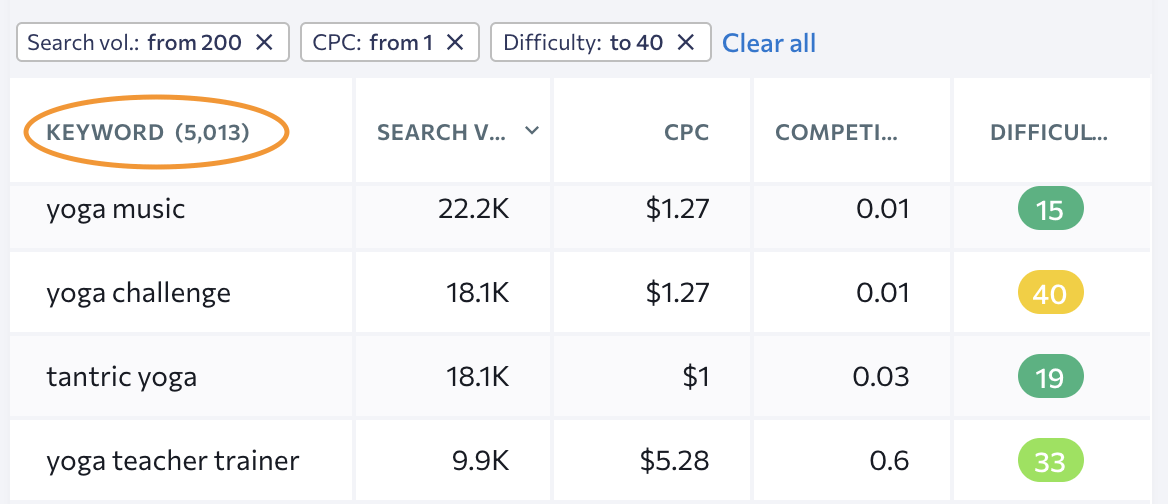
So, all you need to do now is to write down all the keywords you find interesting to write about.
Your goal is to develop a list of keywords with reasonable search volume, commercial value, and low competition. Once you have all this, you can start planning your content creation strategy.
7. Write Amazing blog posts.
Your content is going to be the backbone of your website.
Content is the reason why people will come back to your site and not to others. That is why your content must be epic if you want to make it to search engine results ranking on Google and outrank your competition.
In order to do that, every article you write needs to be thorough and well-written. There was a time when the number of posts you wrote per month was significant, but not anymore.
Because of the current online competition, quality primes over quantity. And the benefits of blogging for business are many. You don’t need to post every couple of days. Instead, stick to a schedule you can manage and produce only high-quality content.
Content Creation Guidelines.
- Write thoroughly and well-written articles. Try to cover the topic in-depth and try to write at the very least 600 words. You can use Grammarly for your spelling.
- Keyword-focused articles. Use your keyword along with the article at least 4 or 5 times. Include it in the headers (H2), URL, title, and meta description to improve your chances of ranking.
- Pay attention to the design. Use Paragraphs, bullet points, numbers, and pictures, and use a clean structure. Readability is not only important for SEO but also to keep your readers.
- Add value to the reader. Your article should solve a problem and should cover it from all angles.
- Link internally and externally. Your link-building strategy is key for SEO. Link your related content internally. Also, include external links to authority sites as references. This will help your SEO game.
- Give something different. If you write the same and in the same way other people do, you will hardly get noticed. So, you should try a different design and use your own voice when writing about any topic.
- Spy your niche competitors. The best way to know how good you need to be is by checking on Google your competitors. Type the keywords you are targeting in Google and check the top 3 results. It would help if you aimed to write something better than those articles.
Resources:
- Check 10+ Content Writing Tips For Beginners To Skyrocket Your Reads to create unique and amazing content.
- Also, you need to avoid these amateur blogging mistakes.
In summary, the journey to niche blogging is not fast. Although creating your niche website is not hard or slow, creating epic content and getting consistent traffic is tough and takes time. So, if you are confident you want to invest your time in it, I encourage you to continue. However, if you need to create something fast, niche blogging is not it.
For more info on this topic, read the full article in the link below:
How to make money with a niche blog.
The ultimate objective of niche blogging is to make money online.
There are different ways you can make money with your website. I will show you some of the best methods you can use to monetize your website.
1. Sell Your Own Products/ Services.
Of all the ways you can make money, selling your own products or services can be one of the most profitable.
Creating a product or service might take you some time, though. First, you’ll need to research and find a product or service your audience will be interested in. I suggest you read my step-by-step guide to digital product creation. This guide will teach you all you need to do to create a successful product.
On the other hand, if what you plan is to provide a service, you might want to focus on drop servicing.
Once your product or service is ready, the next step should be to create a compelling landing page. This is where you want to convert your readers into subscribers and potential customers.
Some ideas are:
- Products:
- Create an App for phones.
- Create physical products that solve a problem in your niche.
- Create a software tool with the help of a developer.
- Create an e-commerce store to sell products.
- Services:
- Coaching.
- Developer.
- SEO.
- Website creation.
2. affiliate marketing.
Affiliate marketing is the process of earning a commission by promoting other people’s products. In essence, find a product you like, promote it on your site, and earn a piece of the profit for each sale that you make.
It is a great way to monetize a website and is used by many marketers. In order to make money with affiliate marketing:
Step #1. Join Good Affiliate Networks.
There are many affiliate networks out there. But you should only apply to affiliate programs related to your niche.
Some of the factors that differentiate good affiliate programs are:
- Choose programs with high commissions that are recurring.
- Chooses affiliates with a long cookie lifespan.
- Go for evergreen products with great brand recognition.
- Use attractive and professional-looking materials.
- Look for programs that offer affiliate partner training.
I suggest you check this post with the 20 best affiliate marketing niches, including affiliate programs to join.
Step #2. Drive traffic to your affiliate posts.
You must implement different traffic strategies once you have created useful and relevant content. This will help to reach a larger audience that might click on your affiliate links.
Organic traffic is the best way to drive targeted traffic to your posts. And to get organic traffic, you should optimize for SEO (search engine optimization), which we discussed previously. Moreover, you can also send traffic to your site with social media or forums like Quora and Reddit.
Otherwise, you can reach more people with targeted ads if you have a website without much traffic. But if you don’t have much budget, check these free traffic sources to increase website visits.
Step #3. Get Clicks On Your Affiliate Links.
Unfortunately, creating good content and sending traffic is not enough. If you want people to click on your affiliate links, you must place them strategically.
Some tips to make this happen are:
- Place affiliate links at the top or in an easy place to see. You can even use bold or colored boxes.
- Include contextual links throughout your content. Just do not drop a link. You need to provide context if you want people to click on a link.
- Add affiliate links into call to action buttons. This is a very eye-catching technique that works well.
- Create review posts, tutorials, and listicles. These articles normally work very well for affiliates.
Lastly, you can learn how to earn a passive income with Facebook and Pinterest affiliate marketing.
3. Sponsored Content.
Sponsored content is a collaboration between you as a publisher and the brands you partner with. In this case, a brand pays you to create content for them and publish it on your site. It can be from a product or service review, an informational article, an announcement, etc.
This will happen when brands are interested in your audience and if you have considerable traffic. Most of the time, brands will find you. But you can also pitch brands and offer yourself to write sponsored content for them. In this case, you’ll need to make clear the value you offer them by creating a sponsored post.
4. Subscription/ Membership Website.
This would be to charge your readers to access specific content. For example, you could offer free articles to drive traffic and engage people and paid articles with much more insights and value.
You can also charge a monthly fee to your subscribers in exchange for accessing content like weekly videos, podcasts, or any kind of training.
The good news is that creating a membership website is incredibly easy. You just need a tool like MemberMouse that makes it all for you. It is straightforward to use and offers a 14-day trial to ensure it is the right tool for your business.
5. Set Up Online Courses (Coaching)
You can monetize your website by providing online training if you have valuable knowledge to share. It could be from simple PDF downloads to podcasts or video training.
Many entrepreneurs have been recurring to this method in the last few years since it has proved to be one of the most efficient.
I suggest you check these two resources that will help you create and sell online courses even if you don’t have any experience:
- How To Sell Online Courses From Your Own Website. This will help you if you want to create your online course from your own website.
- How To Create An Online Course And Sell It: The Definitive Guide. This is a complete guide covering all about creating and selling online courses.
6. Pay Per Click Advertising (PPC)
PPC is an online advertising model where website owners can gain passive income each time a reader clicks on an advertisement banner.
Ads used to be one of the most common ways to monetize websites. However, there are three downsides to them:
- You need a lot of traffic to make good money.
- The user experience can not be as good.
- Most people use ad blockers these days.
Having said so, many businesses use ads as their primary source of income. You could use platforms like Google Adsense, Media.net, VigLink, etc.
Alternatively, you can sell ad space to other businesses for a monthly fee.
Resources:
Promoting your niche blog.
If you have made it this far and don’t promote your blog content, all the work will be useless.
There are millions of blog posts published each day. This means your chances of being found with no promotion are very limited. And you have not worked that much for anything.
You might be relying only on SEO, but having some activity on your social media platforms will help you boost your SEO strategy and drive traffic to your site faster.
So I will tell you 4 methods to effectively promote your blog content.
Method #1. Email Your Subscribers.
Emailing your list of subscribers is one of the best ways to start driving traffic to your blog posts. It would help if you tried to engage your audience and ask them to comment, like, or share to reach even more people.
Since your emails will target people who opt to subscribe to your blog, they will be more likely to engage with your content.
I have tried many email marketing tools, but the one I am using now is Convertkit. Convertkit is easy to manage, the features included are awesome, and you can create a free account.
Method #2. Use Social Media.
Social media can still be an effective way to promote your site and drive traffic. This method will work better if you have previously spent some time cultivating your social media presence and engaging with your audience. All you need to do is to share your articles on social media. But try to provide some helpful insights on your titles to incite the click.
Use a tool like Social Pilot to manage all your networks at once and deliver your content efficiently. You can publish your articles to your different networks (Facebook, Instagram, Pinterest, etc.) from different angles.
For instance, let’s say your article is about “vegan recipes.” Within that article, you have a section with “vegan sandwiches” and “vegan desserts.” Then, you could use three different titles to promote the same article in your networks differently. By sharing the same article with different titles, your chances of getting to different people will increase.
In any case, sharing an article on your social media just once is not enough. Remember the amount of work you have spent working on it. So you want to put it in front of as many eyeballs as possible and publish it 3 or 4 times at least across your social media platforms.
Method #3. Answer Questions In Forums (Quora, Reddit).
Forums can be another great way to promote your articles.
Many people go to forums each day, trying to find a solution to their problems. All you need to do is find where people in your niche gather and answer their questions, including a link to your blog post.
But don’t simply copy and paste your blog URL into each answer. It can be considered spam and might get you blocked. Instead, try to genuinely help people with useful answers and add the URL at the end of your answer.
You can find forums easily by typing in Google “[Your keyword]” + forums.
Some of the best forums you can use for this purpose are:
- Quora
- Facebook groups
Method #4. Reach out to influencers.
Reaching out to influencers in your niche is one of the best opportunities to promote your blog. Although it requires hard work and plenty of rejections, it can be a powerful link-building strategy that can also give you exposure.
To get an influencer to help, you must build a relationship with the influencer before asking for a favor.
The best way is to follow the influencer on their social media platform and engage with their work. That can help you be noticed and form a relationship with the influencer. Once you do that, you must write a short email with your objective and state what’s in for them. No one works for free… For example, you can ask to share an article you just posted that might interest their audience, and in return, you add a backlink in that article to some of their work.
Method #5. Use paid ads.
The methods discussed above are all free options. But if you have some budget, paid advertising is a great way to quickly get exposure to a larger audience. All you need to do is find where your audience hangs out and create an ad on that platform.
Also, it will depend on the kind of post you want to promote and in what niche. For some, the best advert format will be images; for others, text or video.
Some of the best platforms for paid advertisement are:
Resources:
Micro niche Blogging.
What is a micro niche blog?
A micro niche website is a very specific site that focuses only on one topic.
The only difference between a niche blog from a micro-niche blog is that niche sites can cover more topics within a niche, whereas a micro niche website focuses on just one topic.
For instance:
- A blog focused on “Yoga” would be a niche blog. It can cover all related to yoga, like routines, exercises, accessories, etc.
- A blog focused on “Yoga tourism” would be a micro-niche blog. This kind of blog would be focused on creating content exclusively for people who travel with the specific purpose of experiencing some form of yoga.
How to start a micro niche blogging site.
Building a micro niche blog is probably the easiest way to rank and make money with a blog in 2023.
Remember we covered how to start a niche website in 7 steps previously? Well, starting a micro-niche blog is pretty much the same. You still need to perform steps #1 to #7:
- Find a niche.
- Pick your domain and hosting.
- Install WordPress.
- Install a theme.
- Make your logo.
- Plan your content strategy.
- Write amazing blog posts.
The only differences are:
- You’ll need to find a niche with enough search volume. Since you will be covering one topic, make sure there is enough interest; otherwise, you will struggle to drive traffic and monetize.
- Niche keyword research is vital to finding enough topics with search volume, commercial value, and low competition.
- Your blog posts should be extensive (+1,500 words) and cover every angle of your selected keyword. This will increase your chances of ranking for your keywords and build authority.
- Link building is also a crucial part of building authority and improving rankings.
Lastly, I have covered this topic in depth in my article Micro Niche Blogging In 10 Actionable Steps. So I suggest you check it if you want to create a micro niche website, which will be easier to grow.
best niches for blogging.
Not all niches are good for blogging.
While it is very true that you can blog about anything, it is also true that not all topics have the same earning power. For this reason, if your goal is to make money, you need a blog niche with potential.
Since I have covered this topic in-depth in my niche research article, I will provide you here with a list of some of the best blogging niches that can make you money:
- Eco-Friendly Products. Great to write product reviews and make money with the Amazon affiliate program.
- Vegan Recipes. Very trending niche, easy to monetize with ads and sponsored content.
- Movie & TV Reviews. We live in the Netflix era, and most of us are always looking for good shoes to watch next. This can be easy to monetize with affiliate marketing and subscriptions.
- Diet & Fitness. It’s probably one of the most evergreen niches which never lose interest over time. These blogs can make money with affiliate marketing, memberships, sponsored content, and more.
- Home Security. Affordable home security systems and people willing to live off the grid make this a trendy niche. Ecommerce stores with home security systems and affiliate marketing are some ways to make money.
- Online Training. This is one of the latest trends, and almost any niche can provide some kind of online training. Creating a marketplace for online training could be a great solution, including a blog section about online training.
- Fashion for Men. It seems that fashion is gaining lots of new adapts among men. This can be a great blog to monetize with e-commerce stores or affiliate marketing.
- Parenting. This topic has exploded in popularity over the last couple of years. It is all about finding a new approach to make this a very profitable niche to monetize with any method.
- Food for Pets. Pets have been a very popular niche with great earning potential. But since more and more people own pets and just want the best for them, food for pets is a blogging niche that can work incredibly well.
Tips to create a niche blog that makes money.
- Choose a topic you have a passion for. This will help you a lot when creating content. You will be able to show your expertise and write more engaging pieces of content.
- Focus on your audience. Avoid writing for a broad audience. Instead, target your ideal reader/customer.
- Optimize your content for search. Driving traffic to a blog takes time. So, the sooner you start with SEO, the better.
- Create lots of evergreen content. You have better chances of staying on top if your content is evergreen.
- Create something unique. I know this might be hard, but there is a lot of competition out there, and you need to stand out somehow. I suggest you start with these content writing tips.
- Use free traffic sources to drive traffic to your website.
Resources:
Did you enjoy this article?
I’ve put so much effort into writing this comprehensive guide to provide value to the blogging community. It’ll be very helpful for me if you consider sharing it on social media networks.
Share it on social media!
Need help with your digital marketing strategy?
Let me help you to increase your site traffic with Niche SEO optimizations.